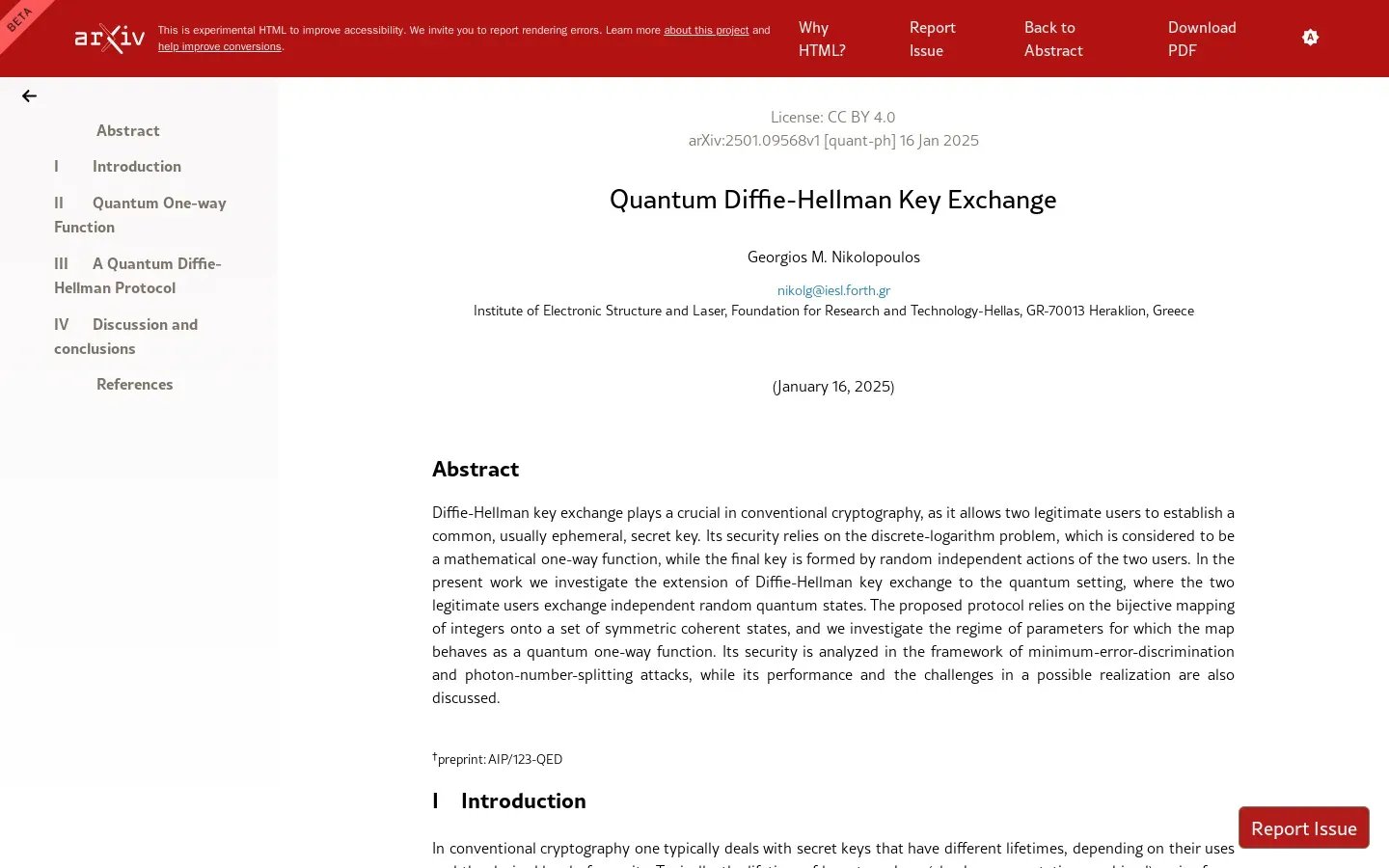
Advancements in Quantum Diffie-Hellman Key Exchange Protocol
/ 4 min read
Quick take - Recent research into Quantum Key Distribution and the Quantum Diffie-Hellman key exchange protocol has revealed advancements aimed at enhancing cybersecurity through improved eavesdropping detection and the practical application of quantum cryptographic systems.
Fast Facts
- Recent research enhances Quantum Key Distribution (QKD) and Quantum Diffie-Hellman (QDH) protocols to improve cybersecurity against eavesdropping threats.
- Key methodologies include integrating QKD systems, implementing error correction, and conducting security analyses against quantum attacks.
- Significant findings include robust authentication mechanisms, the establishment of Quantum One-Way Functions (QOWFs), and successful performance evaluations of the QDH protocol.
- The research highlights the potential of quantum technologies to transform cybersecurity practices and emphasizes the need for quantum-resistant protocols.
- Future directions focus on real-world testing, integration with classical systems, and the exploration of quantum network architectures for enhanced security.
In today’s rapidly evolving digital landscape, where cyber threats loom larger than ever, the quest for robust security measures has never been more critical. As traditional cryptographic methods face challenges from increasing computational power and sophisticated attacks, researchers are turning to the realm of quantum mechanics for solutions. The exploration of advanced eavesdropping strategies and their implications for cybersecurity is paving the way for innovative protocols that promise unparalleled protection against interception and tampering. At the forefront of this research is the Quantum Diffie-Hellman (QDH) key exchange protocol, a beacon of hope for secure communications.
The foundation of QDH lies in its ability to leverage quantum principles to ensure secure key distribution. Researchers emphasize the importance of encoding secret bits effectively while integrating advanced techniques such as dual-homodyne detection and minimum-error discrimination measurements. These methodologies not only enhance the fidelity of information transfer but also bolster defenses against potential eavesdropping attempts. Through interference and measurement, scientists are identifying vulnerabilities that could be exploited by attackers, leading to improved protocols that can withstand both current and emerging threats.
Despite these promising advancements, there remain significant limitations within existing frameworks. Integration with classical cryptographic systems poses a challenge, as does the potential vulnerability to photon-number-splitting (PNS) attacks. The Chernoff Bound indicates that under certain conditions, the security assurances provided by quantum protocols may diminish, underscoring the need for rigorous security analyses against quantum attacks. Addressing these issues requires continuous innovation, particularly in developing quantum-resistant protocols capable of withstanding future threats.
Among the strengths of recent research are robust authentication mechanisms and error correction strategies that enhance privacy during key exchanges. The dual focus on error reconciliation and privacy amplification ensures that even if an attack were attempted, any intercepted data would provide little value to the intruder. This layered approach demonstrates a significant advancement in our understanding of quantum key distribution (QKD) systems, emphasizing their practical applicability in real-world scenarios.
Looking ahead, several avenues for future exploration emerge from the findings surrounding QDH. One such direction involves the implementation of QDH in secure communication networks, which will require extensive real-world testing to evaluate performance under practical constraints. Additionally, exploring quantum network architectures could lead to groundbreaking developments in how we share information securely across vast distances. The integration of these protocols with existing systems will play a crucial role in creating resilient cybersecurity infrastructures.
As we stand on the precipice of a new era in cybersecurity driven by quantum technologies, it is essential to recognize the transformative potential they hold. Ongoing research into QKD and related frameworks not only addresses current cybersecurity challenges but also prepares us for a future where threats continue to evolve alongside technological advancements. With every step forward in understanding quantum mechanics’ applications in cryptography, we move closer to ensuring that our digital communication remains secure against all forms of malicious intent. The journey into this uncharted territory promises not just enhanced security but a redefinition of our approach to protecting sensitive information in an increasingly interconnected world.



